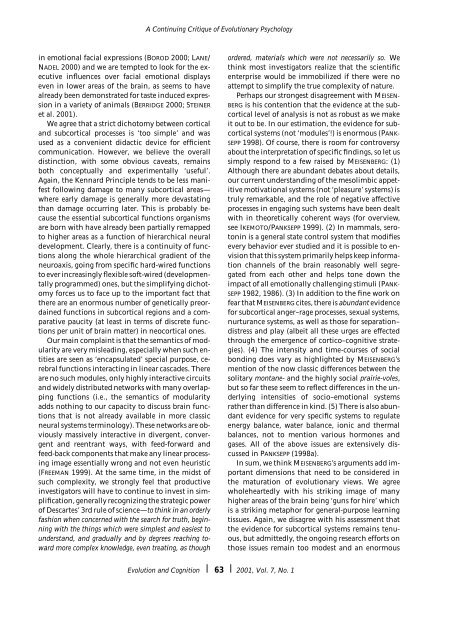The Seven Sins of Evolutionary Psychology - Konrad Lorenz Institute
The Seven Sins of Evolutionary Psychology - Konrad Lorenz Institute
The Seven Sins of Evolutionary Psychology - Konrad Lorenz Institute
You also want an ePaper? Increase the reach of your titles
YUMPU automatically turns print PDFs into web optimized ePapers that Google loves.
A Continuing Critique <strong>of</strong> <strong>Evolutionary</strong> <strong>Psychology</strong>in emotional facial expressions (BOROD 2000; LANE/NADEL 2000) and we are tempted to look for the executiveinfluences over facial emotional displayseven in lower areas <strong>of</strong> the brain, as seems to havealready been demonstrated for taste induced expressionin a variety <strong>of</strong> animals (BERRIDGE 2000; STEINERet al. 2001).We agree that a strict dichotomy between corticaland subcortical processes is ‘too simple’ and wasused as a convenient didactic device for efficientcommunication. However, we believe the overalldistinction, with some obvious caveats, remainsboth conceptually and experimentally ‘useful’.Again, the Kennard Principle tends to be less manifestfollowing damage to many subcortical areas—where early damage is generally more devastatingthan damage occurring later. This is probably becausethe essential subcortical functions organismsare born with have already been partially remappedto higher areas as a function <strong>of</strong> hierarchical neuraldevelopment. Clearly, there is a continuity <strong>of</strong> functionsalong the whole hierarchical gradient <strong>of</strong> theneuroaxis, going from specific hard-wired functionsto ever increasingly flexible s<strong>of</strong>t-wired (developmentallyprogrammed) ones, but the simplifying dichotomyforces us to face up to the important fact thatthere are an enormous number <strong>of</strong> genetically preordainedfunctions in subcortical regions and a comparativepaucity (at least in terms <strong>of</strong> discrete functionsper unit <strong>of</strong> brain matter) in neocortical ones.Our main complaint is that the semantics <strong>of</strong> modularityare very misleading, especially when such entitiesare seen as ‘encapsulated’ special purpose, cerebralfunctions interacting in linear cascades. <strong>The</strong>reare no such modules, only highly interactive circuitsand widely distributed networks with many overlappingfunctions (i.e., the semantics <strong>of</strong> modularityadds nothing to our capacity to discuss brain functionsthat is not already available in more classicneural systems terminology). <strong>The</strong>se networks are obviouslymassively interactive in divergent, convergentand reentrant ways, with feed-forward andfeed-back components that make any linear processingimage essentially wrong and not even heuristic(FREEMAN 1999). At the same time, in the midst <strong>of</strong>such complexity, we strongly feel that productiveinvestigators will have to continue to invest in simplification,generally recognizing the strategic power<strong>of</strong> Descartes’ 3rd rule <strong>of</strong> science—to think in an orderlyfashion when concerned with the search for truth, beginningwith the things which were simplest and easiest tounderstand, and gradually and by degrees reaching towardmore complex knowledge, even treating, as thoughordered, materials which were not necessarily so. Wethink most investigators realize that the scientificenterprise would be immobilized if there were noattempt to simplify the true complexity <strong>of</strong> nature.Perhaps our strongest disagreement with MEISEN-BERG is his contention that the evidence at the subcorticallevel <strong>of</strong> analysis is not as robust as we makeit out to be. In our estimation, the evidence for subcorticalsystems (not ‘modules’!) is enormous (PANK-SEPP 1998). Of course, there is room for controversyabout the interpretation <strong>of</strong> specific findings, so let ussimply respond to a few raised by MEISENBERG: (1)Although there are abundant debates about details,our current understanding <strong>of</strong> the mesolimbic appetitivemotivational systems (not ‘pleasure’ systems) istruly remarkable, and the role <strong>of</strong> negative affectiveprocesses in engaging such systems have been dealtwith in theoretically coherent ways (for overview,see IKEMOTO/PANKSEPP 1999). (2) In mammals, serotoninis a general state control system that modifiesevery behavior ever studied and it is possible to envisionthat this system primarily helps keep informationchannels <strong>of</strong> the brain reasonably well segregatedfrom each other and helps tone down theimpact <strong>of</strong> all emotionally challenging stimuli (PANK-SEPP 1982, 1986). (3) In addition to the fine work onfear that MEISENBERG cites, there is abundant evidencefor subcortical anger–rage processes, sexual systems,nurturance systems, as well as those for separation–distress and play (albeit all these urges are effectedthrough the emergence <strong>of</strong> cortico–cognitive strategies).(4) <strong>The</strong> intensity and time-courses <strong>of</strong> socialbonding does vary as highlighted by MEISENBERG’smention <strong>of</strong> the now classic differences between thesolitary montane- and the highly social prairie-voles,but so far these seem to reflect differences in the underlyingintensities <strong>of</strong> socio–emotional systemsrather than difference in kind. (5) <strong>The</strong>re is also abundantevidence for very specific systems to regulateenergy balance, water balance, ionic and thermalbalances, not to mention various hormones andgases. All <strong>of</strong> the above issues are extensively discussedin PANKSEPP (1998a).In sum, we think MEISENBERG’s arguments add importantdimensions that need to be considered inthe maturation <strong>of</strong> evolutionary views. We agreewholeheartedly with his striking image <strong>of</strong> manyhigher areas <strong>of</strong> the brain being ‘guns for hire’ whichis a striking metaphor for general-purpose learningtissues. Again, we disagree with his assessment thatthe evidence for subcortical systems remains tenuous,but admittedly, the ongoing research efforts onthose issues remain too modest and an enormousEvolution and Cognition ❘ 63 ❘ 2001, Vol. 7, No. 1








